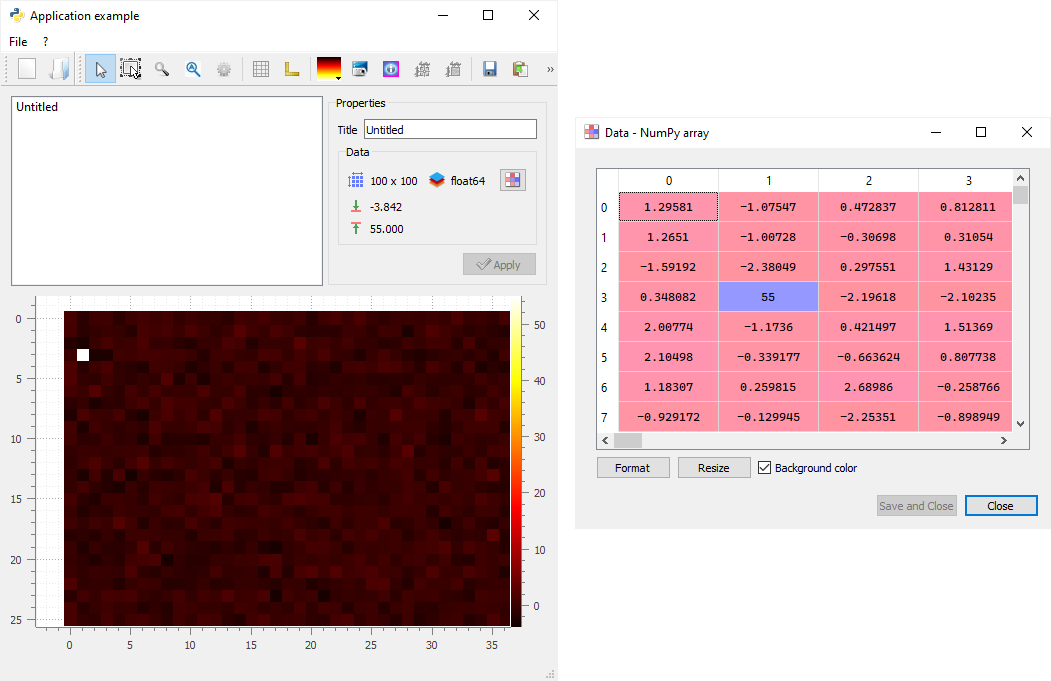Examples — PlotPy 2.8 Manual (original) (raw)
The test launcher¶
A lot of examples are available in the plotpy.tests test module
from plotpy.tests import run run()
The two lines above execute the test launcher:
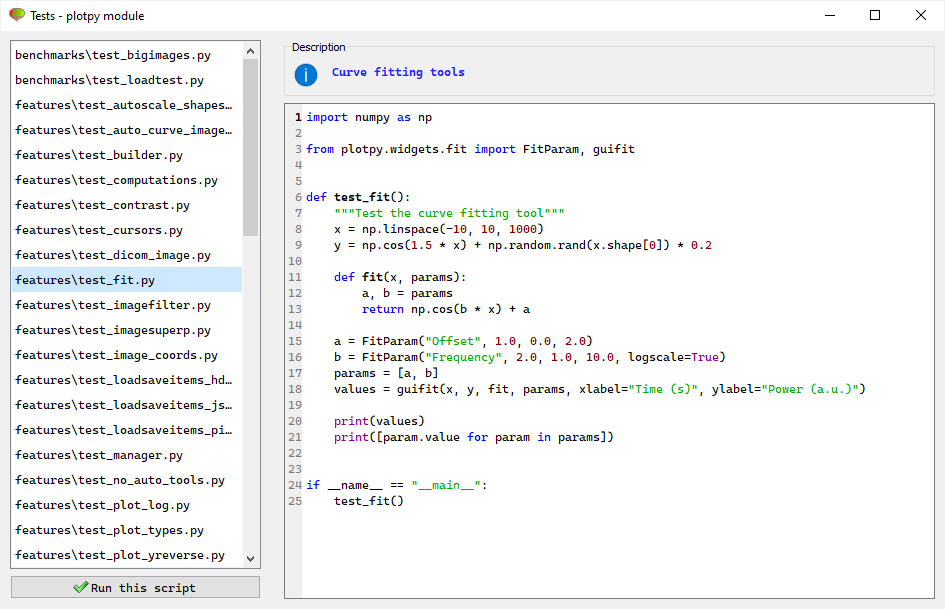
Curve plotting¶
Basic curve plotting¶

Computations on curves¶
import numpy as np import scipy.integrate as spt from guidata.qthelpers import qt_app_context
from plotpy.builder import make from plotpy.tests import vistools as ptv
def test_computations(): """Test computations""" x = np.linspace(-10, 10, 1000) y = np.sin(np.sin(np.sin(x))) with qt_app_context(exec_loop=True): curve = make.curve(x, y, "ab", "b") range = make.xrange(-2, 2) disp0 = make.range_info_label( range, "BR", "x = %.1f ± %.1f cm", title="Range infos" )
disp1 = make.computation(
range, "BL", "trapz=%g", curve, lambda x, y: spt.trapezoid(y, x)
)
disp2 = make.computations(
range,
"TL",
[
(curve, "min=%.5f", lambda x, y: y.min()),
(curve, "max=%.5f", lambda x, y: y.max()),
(curve, "avg=%.5f", lambda x, y: y.mean()),
],
)
legend = make.legend("TR")
_win = ptv.show_items(
wintitle="Plot computations",
items=[curve, range, disp0, disp1, disp2, legend],
plot_type="curve",
)if name == "main": test_computations()
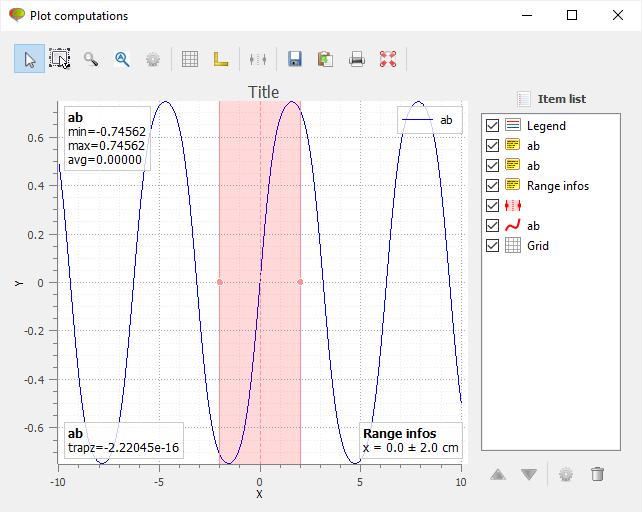
Curve fitting¶
import numpy as np
from plotpy.widgets.fit import FitParam, guifit
def test_fit(): """Test the curve fitting tool""" x = np.linspace(-10, 10, 1000) y = np.cos(1.5 * x) + np.random.rand(x.shape[0]) * 0.2
def fit(x, params):
a, b = params
return np.cos(b * x) + a
a = FitParam("Offset", 0.7, -1.0, 1.0)
b = FitParam("Frequency", 1.2, 0.3, 3.0, logscale=True)
params = [a, b]
values = guifit(x, y, fit, params, xlabel="Time (s)", ylabel="Power (a.u.)")
print(values)
print([param.value for param in params])if name == "main": test_fit()
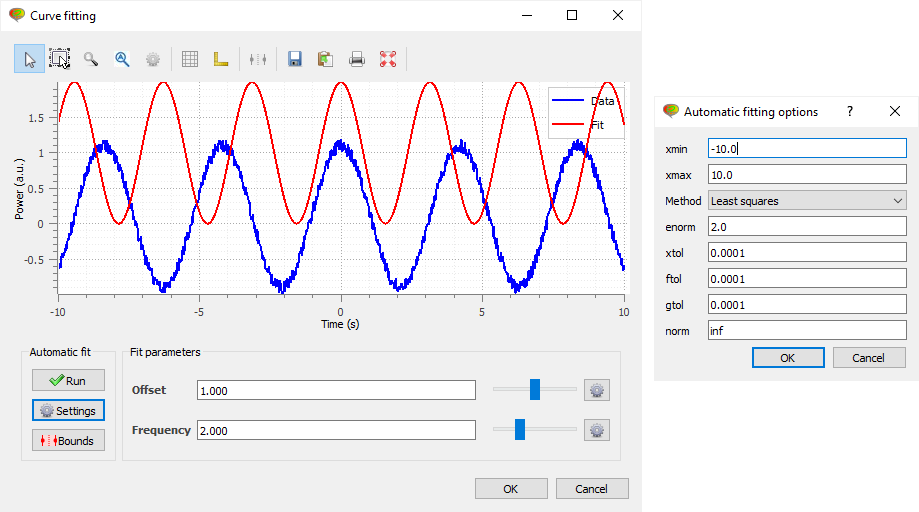
Image visualization¶
Image contrast adjustment¶
import os import os.path as osp
from guidata.env import execenv from guidata.qthelpers import qt_app_context
from plotpy.builder import make from plotpy.tests import get_path from plotpy.tests.data import gen_image1
def __create_dialog_with_contrast(item): """Create plot dialog with contrast panel
Args:
Item: item to be added to the plot
"""
win = make.dialog(
edit=False,
toolbar=True,
wintitle="Contrast test",
show_contrast=True,
type="image",
size=(600, 600),
)
plot = win.get_plot()
plot.add_item(item)
plot.set_active_item(item)
item.unselect()
win.show()
return windef test_contrast1(): """Contrast test 1""" with qt_app_context(exec_loop=True): item = make.image(filename=get_path("brain.png"), colormap="gray") win = __create_dialog_with_contrast(item) fname = "contrast.png" try: win.get_plot().save_widget(fname) except IOError: # Skipping this part of the test # because user has no write permission on current directory pass if execenv.unattended and osp.isfile(fname): os.unlink(fname)
def test_contrast2(): """Contrast test 2
Test if level histogram is really removed when the associated image is removed from
the plot (the validation is not automatic)
"""
with qt_app_context(exec_loop=True):
item1 = make.image(filename=get_path("brain.png"), colormap="gray")
win = __create_dialog_with_contrast(item1)
plot = win.get_plot()
plot.del_item(item1)
item2 = make.image(gen_image1())
plot.add_item(item2)
plot.set_active_item(item2)if name == "main": # test_contrast1() test_contrast2()
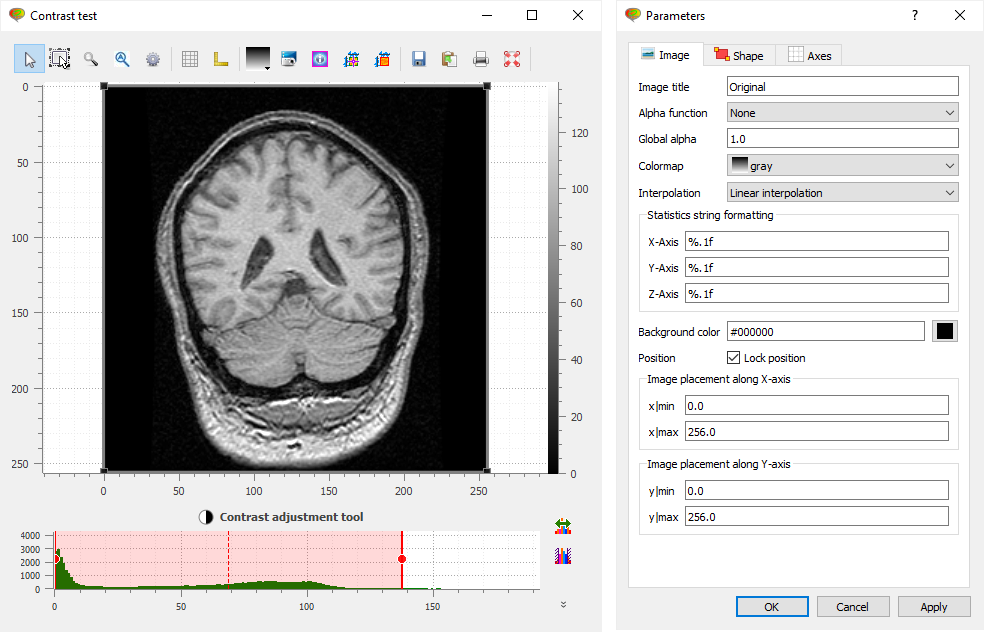
Image cross-sections¶
import numpy as np from guidata.qthelpers import qt_app_context
from plotpy.builder import make from plotpy.tests import get_path
def create_window(): win = make.dialog( edit=False, toolbar=True, wintitle="Cross sections test", show_xsection=True, show_ysection=True, type="image", size=(640, 600), ) return win
def test_cross_section(): """Test cross section""" with qt_app_context(exec_loop=True): filename = get_path("brain.png") win = create_window() win.show() image = make.image(filename=filename, colormap="bone") data2 = np.array(image.data.T[200:], copy=True) image2 = make.image(data2, title="Modified", alpha_function="linear") plot = win.manager.get_plot() plot.add_item(image) plot.add_item(image2, z=1)
if name == "main": test_cross_section()
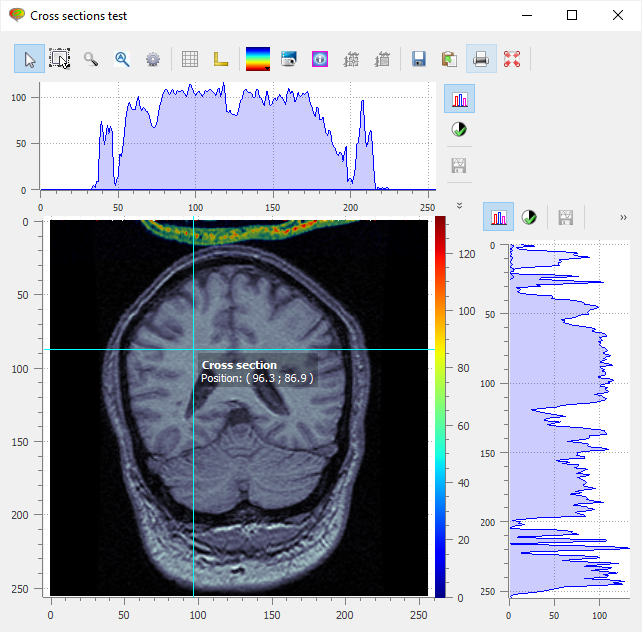
Transformable images¶
Affine transforms example on 3000x3000 images (real-time transforms):
from future import annotations
import os
import numpy as np import pytest from guidata.env import execenv from guidata.qthelpers import qt_app_context from qtpy import QtCore as QC from qtpy import QtGui as QG
from plotpy import io from plotpy.builder import make from plotpy.constants import LUTAlpha from plotpy.items import TrImageItem, assemble_imageitems from plotpy.tests import vistools as ptv from plotpy.tests.data import gen_image4
DEFAULT_CHARS = "".join([chr(c) for c in range(32, 256)])
def get_font_array(sz: int, chars: str = DEFAULT_CHARS) -> np.ndarray | None: """Return array of font characters
Args:
sz: Font size
chars: Characters to include (default: all printable characters)
Returns:
Array of font characters
"""
font = QG.QFont()
font.setFixedPitch(True)
font.setPixelSize(sz)
font.setStyleStrategy(QG.QFont.NoAntialias)
dummy = QG.QImage(10, 10, QG.QImage.Format_ARGB32)
pnt = QG.QPainter(dummy)
pnt.setFont(font)
metric = pnt.fontMetrics()
rct = metric.boundingRect(chars)
pnt.end()
h, w = rct.height(), rct.width()
img = QG.QImage(w, h, QG.QImage.Format_ARGB32)
paint = QG.QPainter()
paint.begin(img)
paint.setFont(font)
paint.setBrush(QG.QColor(255, 255, 255))
paint.setPen(QG.QColor(255, 255, 255))
paint.drawRect(0, 0, w + 1, h + 1)
paint.setPen(QG.QColor(0, 0, 0))
paint.setBrush(QG.QColor(0, 0, 0))
paint.drawText(0, paint.fontMetrics().ascent(), chars)
paint.end()
try:
data = img.bits().asstring(h * w * 4)
except AttributeError:
data = img.bits()
npy: np.ndarray = np.frombuffer(data, np.uint8)
return npy.reshape(h, w, 4)[:, :, 0]def write_text_on_array( data: np.ndarray, x: int, y: int, sz: int, txt: str, range: tuple[int, int] | None = None, ) -> None: """Write text in image (in-place)
Args:
data: Image data
x: X-coordinate of top-left corner
y: Y-coordinate of top-left corner
sz: Font size
txt: Text to write
range: Range of values to map to 0-255 (default: None)
"""
arr = get_font_array(sz, txt)
if arr is None:
return
if range is None:
m, M = data.min(), data.max()
else:
m, M = range
z = (float(M) - float(m)) * np.array(arr, float) / 255.0 + m
arr = np.array(z, data.dtype)
dy, dx = arr.shape
data[y : y + dy, x : x + dx] = arrdef make_items(N: int) -> list[TrImageItem]: """Make test TrImageItem items
Args:
N: Image size (N x N)
Returns:
List of image items
"""
data = gen_image4(N, N)
m = data.min()
M = data.max()
items = [make.trimage(data, alpha_function=LUTAlpha.LINEAR, colormap="jet")]
for dtype in (np.uint8, np.uint16, np.int8, np.int16):
info = np.iinfo(dtype().dtype) # pylint: disable=no-value-for-parameter
s = float((info.max - info.min))
a1 = s * (data - m) / (M - m)
img = np.array(a1 + info.min, dtype)
write_text_on_array(img, 0, 0, int(N / 15.0), dtype.__name__)
items.append(make.trimage(img, colormap="jet"))
nc = int(np.sqrt(len(items)) + 1.0)
maxy, x, y = 0, 0, 0
w = None
for index, item in enumerate(items):
h = item.boundingRect().height()
if index % nc == 0:
x = 0
y += maxy
maxy = h
else:
x += w
maxy = max(maxy, h)
w = item.boundingRect().width()
item.set_transform(x, y, 0.0)
# item.set_selectable(False)
return itemsdef save_image(name: str, data: np.ndarray) -> None: """Save image to file
Args:
name: Base name of file
data: Image data
"""
for fname in (name + ".u16.tif", name + ".u8.png"):
if os.path.exists(fname):
os.remove(fname)
size = int(data.nbytes / 1024.0)
print(f"Saving image: {data.shape[0]} x {data.shape[1]} ({size} KB):")
print(" --> uint16")
io.imwrite(name + ".u16.tif", data, dtype=np.uint16, max_range=True)
print(" --> uint8")
io.imwrite(name + ".u8.png", data, dtype=np.uint8, max_range=True)def get_bbox(items: list[TrImageItem]) -> QC.QRectF: """Get bounding box of items
Args:
items: List of image items
Returns:
Bounding box of items
"""
rectf = QC.QRectF()
for item in items:
rectf = rectf.united(item.boundingRect())
return rectfdef build_image(items: list[TrImageItem]) -> None: """Build image from items
Args:
items: List of image items
"""
r = get_bbox(items)
_x, _y, w, h = r.getRect()
print("-" * 80)
print(f"Assemble test1: {int(w)} x {int(h)}")
dest = assemble_imageitems(items, r, w, h)
if not execenv.unattended:
save_image("test1", dest)
print("-" * 80)
print(f"Assemble test1: {int(w / 4)} x {int(h / 4)}")
dest = assemble_imageitems(items, r, w / 4, h / 4)
if not execenv.unattended:
save_image("test2", dest)
print("-" * 80)@pytest.mark.parametrize("N", [500]) @pytest.mark.parametrize("assemble_images", [False, True]) def test_transform(N: int, assemble_images: bool) -> None: """Test image transforms
Args:
N: Image size (N x N)
assemble_images: If True, assemble images (default: False)
"""
with qt_app_context(exec_loop=True):
items = make_items(N)
_win = ptv.show_items(
items,
wintitle="Transform test ({}x{} images)".format(N, N),
plot_type="image",
show_itemlist=True,
winsize=(1000, 600),
)
if assemble_images:
build_image(items)if name == "main": test_transform(N=500, assemble_images=True)
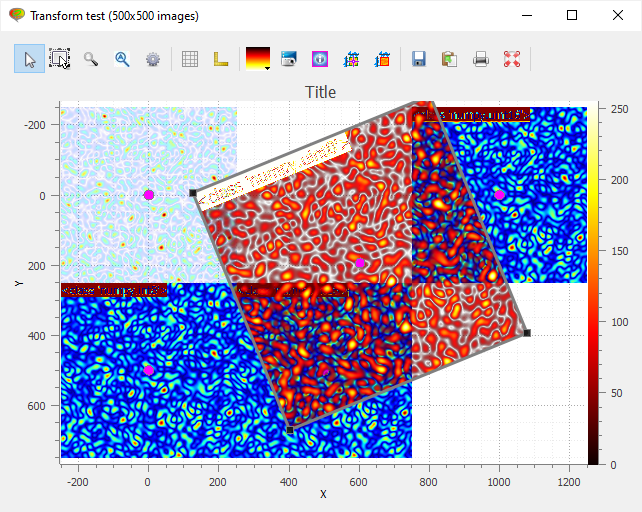
Image rectangular filter¶
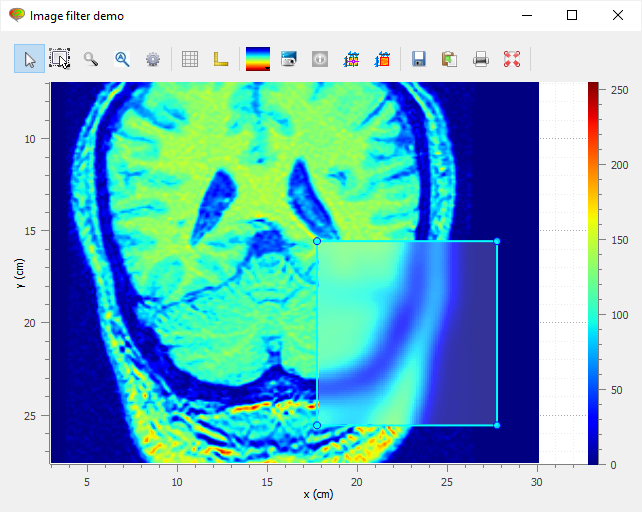
Histograms¶
2-D histogram¶
from guidata.qthelpers import qt_app_context from numpy import array, concatenate, dot, random
from plotpy.builder import make from plotpy.config import _
def hist2d_func(X, Y, Z): with qt_app_context(exec_loop=True): win = make.dialog( edit=True, toolbar=True, wintitle="2-D Histogram X0=(0,1), X1=(-1,-1)", type="image", ) hist2d = make.histogram2D(X, Y, 200, 200, Z=Z, computation=2) curve = make.curve( X[::50], Y[::50], linestyle="", marker="+", title=_("Markers") ) plot = win.manager.get_plot() plot.set_aspect_ratio(lock=False) plot.set_antialiasing(False) plot.add_item(hist2d) plot.add_item(curve) plot.set_item_visible(curve, False) win.show()
def hist2d(X, Y): with qt_app_context(exec_loop=True): win = make.dialog( edit=True, toolbar=True, wintitle="2-D Histogram X0=(0,1), X1=(-1,-1)", type="image", ) hist2d = make.histogram2D(X, Y, 200, 200) curve = make.curve( X[::50], Y[::50], linestyle="", marker="+", title=_("Markers") ) plot = win.manager.get_plot() plot.set_aspect_ratio(lock=False) plot.set_antialiasing(False) plot.add_item(hist2d) plot.add_item(curve) plot.set_item_visible(curve, False) win.show()
def test_hist_2d(): N = 150000 m = array([[1.0, 0.2], [-0.2, 3.0]]) X1 = random.normal(0, 0.3, size=(N, 2)) X2 = random.normal(0, 0.3, size=(N, 2)) X = concatenate((X1 + [0, 1.0], dot(X2, m) + [-1, -1.0])) hist2d(X[:, 0], X[:, 1])
def test_hist_2d_func(): N = 150000 m = array([[1.0, 0.2], [-0.2, 3.0]]) X1 = random.normal(0, 0.3, size=(N, 2)) X2 = random.normal(0, 0.3, size=(N, 2)) X = concatenate((X1 + [0, 1.0], dot(X2, m) + [-1, -1.0])) hist2d_func(X[:, 0], X[:, 1], X[:, 0] + X[:, 1])
if name == "main": test_hist_2d() test_hist_2d_func()
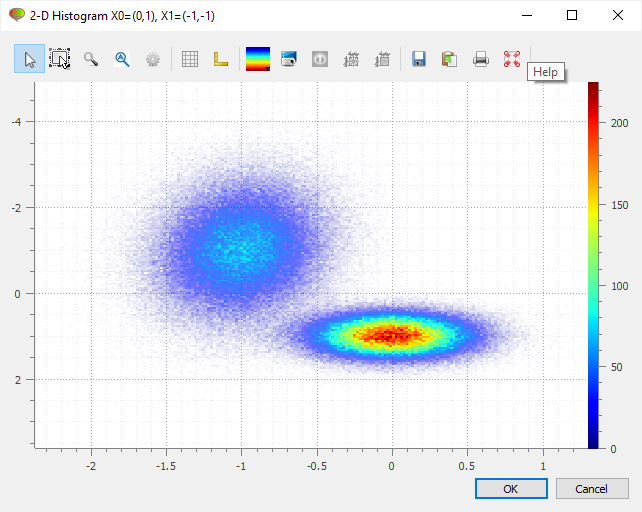
Other examples¶
Dot Array Demo¶
from future import annotations
from typing import TYPE_CHECKING
import guidata.dataset as gds import guidata.dataset.qtwidgets as gdq import numpy as np from guidata.configtools import get_image_file_path from guidata.qthelpers import qt_app_context from qtpy import QtCore as QC from qtpy import QtGui as QG from qtpy import QtWidgets as QW
import plotpy.config # Loading icons # noqa: F401 from plotpy.interfaces import IImageItemType from plotpy.items import RawImageItem from plotpy.items.curve.errorbar import vmap from plotpy.plot import PlotDialog, PlotOptions from plotpy.styles import RawImageParam from plotpy.tools import CopyToClipboardTool, HelpTool, PrintTool, SaveAsTool
if TYPE_CHECKING: from plotpy.interfaces import IItemType
class DotArrayParam(gds.DataSet): """Dot array"""
def _update_cb(self, *args):
"""Update callback, to be overriden"""
pass
g1 = gds.BeginGroup("Size of the area")
dim_h = gds.FloatItem("Width", default=20, min=0, unit="mm")
dim_v = gds.FloatItem("Height", default=20, min=0, unit="mm")
_g1 = gds.EndGroup("Size of the area")
g2 = gds.BeginGroup("Grid pattern properties")
step_x = gds.FloatItem("Step in X-axis", default=1, min=1, unit="mm")
step_y = gds.FloatItem("Step in Y-axis", default=1, min=1, unit="mm")
size = gds.FloatItem("Dot size", default=0.2, min=0, max=2, slider=True, unit="mm")
color = gds.ColorItem("Dot color", default="red")
_g2 = gds.EndGroup("Grid pattern properties")
def update_item(self, obj):
"""Update item from parameters"""
self._update_cb()
def update_param(self, obj):
"""Update parameters from object"""
passclass DotArrayRawImageParam(RawImageParam, DotArrayParam): pass
class DotArrayItem(RawImageItem): """Dot array item"""
def __init__(self, param=None):
super().__init__(np.zeros((1, 1)), param)
self.update_border()
def boundingRect(self):
"""Reimplemented to return the bounding rectangle of the item"""
param = self.param
if param is not None:
return QC.QRectF(
QC.QPointF(-0.5 * param.size, -0.5 * param.size),
QC.QPointF(
param.dim_h + 0.5 * param.size, param.dim_v + 0.5 * param.size
),
)
def types(self) -> tuple[type[IItemType], ...]:
"""Returns a group or category for this item.
This should be a tuple of class objects inheriting from IItemType
Returns:
tuple: Tuple of class objects inheriting from IItemType
"""
return (IImageItemType,)
def draw_image(self, painter, canvasRect, srcRect, dstRect, xMap, yMap):
"""Draw image"""
if self.warn_if_non_linear_scale(painter, canvasRect):
return
painter.setRenderHint(QG.QPainter.Antialiasing, True)
param = self.param
xcoords = vmap(xMap, np.arange(0, param.dim_h + 1, param.step_x))
ycoords = vmap(yMap, np.arange(0, param.dim_v + 1, param.step_y))
rx = 0.5 * param.size * xMap.pDist() / xMap.sDist()
ry = 0.5 * param.size * yMap.pDist() / yMap.sDist()
color = QG.QColor(param.color)
painter.setPen(QG.QPen(color))
painter.setBrush(QG.QBrush(color))
for xc in xcoords:
for yc in ycoords:
painter.drawEllipse(QC.QPointF(xc, yc), rx, ry)class CustomHelpTool(HelpTool): """Custom help tool"""
def activate_command(self, plot, checked):
"""Activate command"""
QW.QMessageBox.information(
plot,
"Help",
"""**to be customized**Keyboard/mouse shortcuts:
- single left-click: item (curve, image, ...) selection
- single right-click: context-menu relative to selected item
- shift: on-active-curve (or image) cursor
- alt: free cursor
- left-click + mouse move: move item (when available)
- middle-click + mouse move: pan
- right-click + mouse move: zoom""", )
class DotArrayDialog(PlotDialog): """Dot array dialog"""
def __init__(self):
self.item = None
self.stamp_gbox = None
super().__init__(
title="Dot array example",
options=PlotOptions(title="Main plot", type="image"),
toolbar=True,
edit=True,
)
self.resize(900, 600)
def register_tools(self):
"""Register tools"""
manager = self.plot_widget.manager
manager.register_standard_tools()
manager.add_separator_tool()
manager.add_tool(SaveAsTool)
manager.add_tool(CopyToClipboardTool)
manager.add_tool(PrintTool)
manager.add_tool(CustomHelpTool)
manager.activate_default_tool()
plot = manager.get_plot()
plot.enableAxis(plot.yRight, False)
plot.set_aspect_ratio(lock=True)
def populate_plot_layout(self):
"""Populate the plot layout
Reimplements the method from PlotDialog"""
self.add_widget(self.plot_widget, row=0, column=0, rowspan=3, columnspan=1)
logo_path = get_image_file_path("plotpy.svg")
logo = QW.QLabel()
logo.setPixmap(QG.QPixmap(logo_path))
logo.setAlignment(QC.Qt.AlignCenter)
self.add_widget(logo, 1, 1)
logo_txt = QW.QLabel("Powered by <b>plotpy</b>")
logo_txt.setAlignment(QC.Qt.AlignHCenter | QC.Qt.AlignTop)
self.add_widget(logo_txt, 2, 1)
self.stamp_gbox = gdq.DataSetEditGroupBox("Dots", DotArrayParam)
self.stamp_gbox.SIG_APPLY_BUTTON_CLICKED.connect(self.apply_params)
self.add_widget(self.stamp_gbox, 0, 1)
def show_data(self, param):
"""Show data"""
plot = self.plot_widget.plot
if self.item is None:
itemparam = DotArrayRawImageParam()
gds.update_dataset(itemparam, param)
param._update_cb = lambda: self.stamp_gbox.get()
self.item = DotArrayItem(itemparam)
plot.add_item(self.item)
else:
gds.update_dataset(self.item.param, param)
self.item.update_border()
plot.do_autoscale()
def apply_params(self):
"""Apply parameters"""
param = self.stamp_gbox.dataset
self.show_data(param)def test_dot_array(): """Test dot array dialog""" with qt_app_context(exec_loop=True): dlg = DotArrayDialog() dlg.apply_params() dlg.show()
if name == "main": test_dot_array()
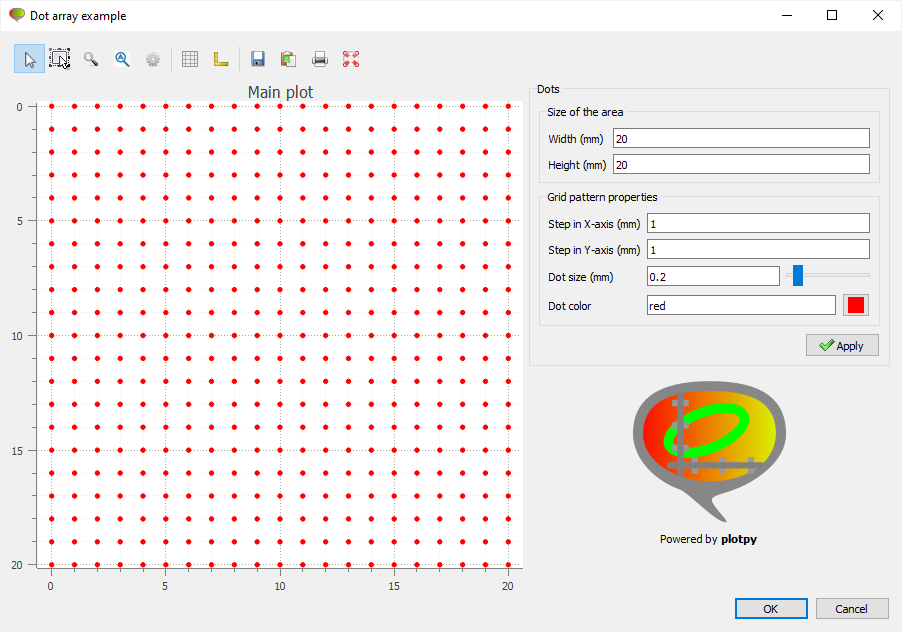
Image plot tools¶
from guidata.qthelpers import qt_app_context from qtpy import QtWidgets as QW
from plotpy.builder import make from plotpy.items import Marker from plotpy.tests import get_path from plotpy.tools import ( AnnotatedCircleTool, AnnotatedEllipseTool, AnnotatedObliqueRectangleTool, AnnotatedPointTool, AnnotatedPolygonTool, AnnotatedRectangleTool, AnnotatedSegmentTool, CircleTool, EllipseTool, HCursorTool, HRangeTool, LabelTool, MultiLineTool, ObliqueRectangleTool, PlaceAxesTool, PolygonTool, RectangleTool, SegmentTool, VCursorTool, XCursorTool, )
TOOLBAR_ID = "toolbar2"
def create_window(): win = make.dialog( edit=False, toolbar=True, wintitle="All image and plot tools test", type="image", size=(800, 600), ) toolbar2 = QW.QToolBar() win.layout().addWidget(toolbar2) win.manager.add_toolbar(toolbar2, TOOLBAR_ID)
for toolklass in (
LabelTool,
HRangeTool,
VCursorTool,
HCursorTool,
XCursorTool,
SegmentTool,
RectangleTool,
ObliqueRectangleTool,
CircleTool,
EllipseTool,
MultiLineTool,
PolygonTool,
PlaceAxesTool,
AnnotatedRectangleTool,
AnnotatedObliqueRectangleTool,
AnnotatedCircleTool,
AnnotatedEllipseTool,
AnnotatedSegmentTool,
AnnotatedPointTool,
AnnotatedPolygonTool,
):
win.manager.add_tool(toolklass, toolbar_id=TOOLBAR_ID)
return windef test_image_plot_tools():
"""Test"""
with qt_app_context(exec_loop=True):
filename = get_path("brain.png")
win = create_window()
win.show()
image = make.image(filename=filename, colormap="bone")
plot = win.manager.get_plot()
plot.add_item(image)
title = "toto"
marker1 = Marker(label_cb=lambda x, y: f"{title}x = {x:g}
y = {y:g}")
plot.add_item(marker1)
marker2 = Marker(label_cb=lambda x, y: f"{title}x = {x:g}
y = {y:g}")
plot.add_item(marker2)
if name == "main": test_image_plot_tools()
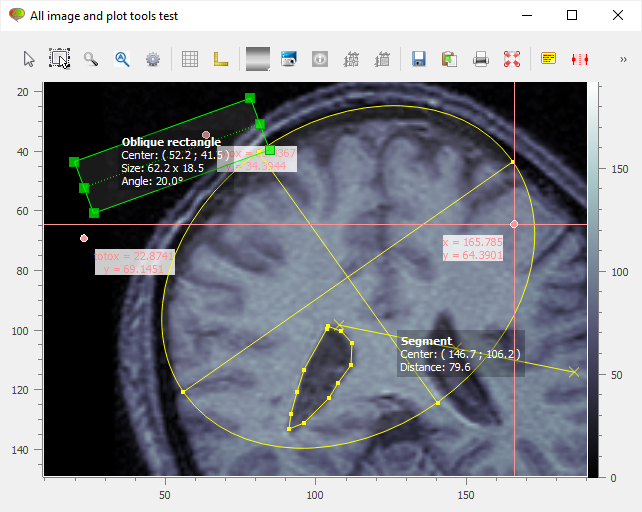
Real-time Mandelbrot plotting¶
import numpy as np from guidata.qthelpers import qt_app_context from qtpy import QtCore as QC
from plotpy.builder import make from plotpy.config import _ from plotpy.items import RawImageItem from plotpy.mandelbrot import mandelbrot from plotpy.tools import ToggleTool
class FullScale(ToggleTool): def init(self, parent, image): super().init(parent, _("MAX resolution"), None) self.image = image self.minprec = image.IMAX self.maxprec = 5 * image.IMAX
def activate_command(self, plot, checked):
if self.image.IMAX == self.minprec:
self.image.IMAX = self.maxprec
else:
self.image.IMAX = self.minprec
self.image.set_lut_range([0, self.image.IMAX])
plot.replot()
def update_status(self, plot):
self.action.setChecked(self.image.IMAX == self.maxprec)class MandelItem(RawImageItem): def init(self, xmin, xmax, ymin, ymax): super().init(np.zeros((1, 1), np.uint8)) self.bounds = QC.QRectF(QC.QPointF(xmin, ymin), QC.QPointF(xmax, ymax)) self.update_border() self.IMAX = 80 self.set_lut_range([0, self.IMAX])
# ---- QwtPlotItem API ------------------------------------------------------
def draw_image(self, painter, canvasRect, srcRect, dstRect, xMap, yMap):
if self.warn_if_non_linear_scale(painter, canvasRect):
return
x1, y1, x2, y2 = canvasRect.toAlignedRect().getCoords()
i1, j1, i2, j2 = srcRect
NX = x2 - x1
NY = y2 - y1
if self.data.shape != (NX, NY):
self.data = np.zeros((NY, NX), np.int16)
mandelbrot(i1, j1, i2, j2, self.data, self.IMAX)
srcRect = (0, 0, NX, NY)
x1, y1, x2, y2 = canvasRect.toAlignedRect().getCoords()
RawImageItem.draw_image(
self, painter, canvasRect, srcRect, (x1, y1, x2, y2), xMap, yMap
)def create_mandelbrot_window(): """Create a Mandelbrot set window""" win = make.window( toolbar=True, wintitle="Mandelbrot", yreverse=False, type="image", ) mandel = MandelItem(-1.5, 0.5, -1.0, 1.0) fstool = win.manager.add_tool(FullScale, mandel) plot = win.get_plot() plot.set_aspect_ratio(lock=False) plot.add_item(mandel) return win, mandel, fstool
def test_mandel(): """Test Mandelbrot set window""" with qt_app_context(exec_loop=True): win, _mandel, _fstool = create_mandelbrot_window() win.show()
if name == "main": test_mandel()
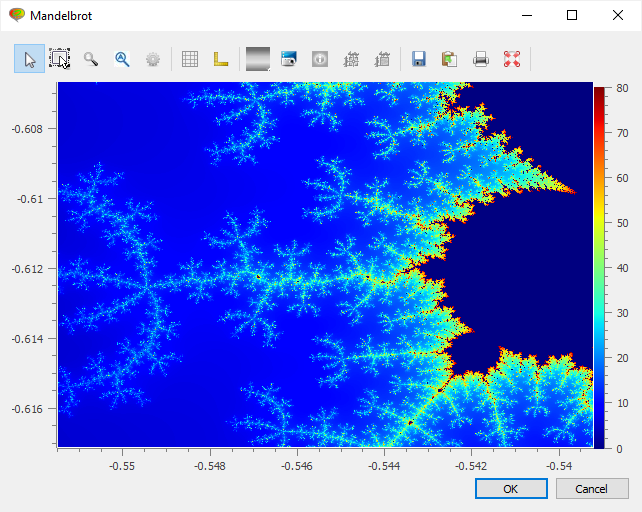
Simple application¶
import sys
import numpy as np from guidata.configtools import get_icon from guidata.dataset import ( ChoiceItem, DataSet, FloatArrayItem, GetAttrProp, IntItem, StringItem, update_dataset, ) from guidata.dataset.qtwidgets import DataSetEditGroupBox from guidata.qthelpers import ( add_actions, create_action, get_std_icon, qt_app_context, win32_fix_title_bar_background, ) from qtpy import QtCore as QC from qtpy import QtWidgets as QW
from plotpy import io from plotpy.builder import make from plotpy.config import _ from plotpy.plot import PlotOptions, PlotWidget from plotpy.tests import get_path from plotpy.widgets import about
class ImageParam(DataSet): hide_data = False hide_size = True title = StringItem(("Title"), default=("Untitled")) data = FloatArrayItem(_("Data")).set_prop("display", hide=GetAttrProp("_hide_data")) width = IntItem( ("Width"), help=("Image width (pixels)"), min=1, default=100 ).set_prop("display", hide=GetAttrProp("_hide_size")) height = IntItem( ("Height"), help=("Image height (pixels)"), min=1, default=100 ).set_prop("display", hide=GetAttrProp("_hide_size"))
class ImageParamNew(ImageParam): _hide_data = True hide_size = False type = ChoiceItem(("Type"), (("rand", _("random")), ("zeros", _("zeros"))))
class ImageListWithProperties(QW.QSplitter): def init(self, parent): QW.QSplitter.init(self, parent) self.imagelist = QW.QListWidget(self) self.addWidget(self.imagelist) self.properties = DataSetEditGroupBox(_("Properties"), ImageParam) self.properties.setEnabled(False) self.addWidget(self.properties)
class CentralWidget(QW.QSplitter): def init(self, parent, toolbar): QW.QSplitter.init(self, parent) self.setContentsMargins(10, 10, 10, 10) self.setOrientation(QC.Qt.Vertical)
imagelistwithproperties = ImageListWithProperties(self)
self.addWidget(imagelistwithproperties)
self.imagelist = imagelistwithproperties.imagelist
self.imagelist.currentRowChanged.connect(self.current_item_changed)
self.imagelist.itemSelectionChanged.connect(self.selection_changed)
self.properties = imagelistwithproperties.properties
self.properties.SIG_APPLY_BUTTON_CLICKED.connect(self.properties_changed)
self.plot_widget = PlotWidget(
self,
options=PlotOptions(type="image", show_contrast=True),
auto_tools=False,
)
self.plot_widget.plot.SIG_LUT_CHANGED.connect(self.lut_range_changed)
self.item = None # image item
self.plot_widget.manager.add_toolbar(toolbar, "default")
self.plot_widget.register_tools()
self.addWidget(self.plot_widget)
self.images = [] # List of ImageParam instances
self.lut_ranges = [] # List of LUT ranges
self.setStretchFactor(0, 0)
self.setStretchFactor(1, 1)
self.setHandleWidth(10)
self.setSizes([1, 2])
def refresh_list(self):
"""Refresh image list"""
self.imagelist.clear()
self.imagelist.addItems([image.title for image in self.images])
def selection_changed(self):
"""Image list: selection changed"""
row = self.imagelist.currentRow()
self.properties.setDisabled(row == -1)
def current_item_changed(self, row):
"""Image list: current image changed"""
if row == -1:
return
image, lut_range = self.images[row], self.lut_ranges[row]
self.show_data(image.data, lut_range)
update_dataset(self.properties.dataset, image)
self.properties.get()
def lut_range_changed(self):
"""LUT range changed"""
row = self.imagelist.currentRow()
self.lut_ranges[row] = self.item.get_lut_range()
def show_data(self, data, lut_range=None):
"""Show image data"""
plot = self.plot_widget.plot
if self.item is not None:
self.item.set_data(data)
if lut_range is None:
lut_range = self.item.get_lut_range()
self.plot_widget.manager.set_contrast_range(*lut_range)
self.plot_widget.manager.update_cross_sections()
else:
self.item = make.image(data, interpolation="nearest")
plot.add_item(self.item, z=0)
plot.select_item(self.item)
plot.do_autoscale()
plot.replot()
def properties_changed(self):
"""The properties 'Apply' button was clicked: updating image"""
row = self.imagelist.currentRow()
image = self.images[row]
update_dataset(image, self.properties.dataset)
self.refresh_list()
self.show_data(image.data)
def add_image(self, image):
"""Add image"""
self.images.append(image)
self.lut_ranges.append(None)
self.refresh_list()
self.imagelist.setCurrentRow(len(self.images) - 1)
plot = self.plot_widget.plot
plot.do_autoscale()
def add_image_from_file(self, filename):
"""Add image from file"""
image = ImageParam()
image.title = str(filename)
image.data = io.imread(filename, to_grayscale=True)
image.height, image.width = image.data.shape
self.add_image(image)
def remove_image(self, index=None):
"""Remove image"""
if index is None:
index = self.imagelist.currentRow()
del self.images[index]
del self.lut_ranges[index]
self.refresh_list()
if self.imagelist.count() > 0:
self.imagelist.setCurrentRow(0)
else:
self.item = None
self.plot_widget.plot.del_all_items()
self.plot_widget.plot.replot()class MainWindow(QW.QMainWindow): """Main Window"""
def __init__(self):
super().__init__()
win32_fix_title_bar_background(self)
self.setup()
def setup(self):
"""Setup window parameters"""
self.setWindowIcon(get_icon("python.png"))
self.setWindowTitle(_("Application example"))
self.resize(QC.QSize(600, 800))
# Welcome message in statusbar:
status = self.statusBar()
status.showMessage(_("Welcome to plotpy application example!"), 5000)
# Set central widget:
main_toolbar = self.addToolBar("Main")
toolbar = self.addToolBar("Image")
self.mainwidget = CentralWidget(self, toolbar)
self.setCentralWidget(self.mainwidget)
# File menu
file_menu = self.menuBar().addMenu(_("File"))
new_action = create_action(
self,
_("New..."),
shortcut="Ctrl+N",
icon=get_icon("filenew.png"),
tip=_("Create a new image"),
triggered=self.new_image,
)
open_action = create_action(
self,
_("Open..."),
shortcut="Ctrl+O",
icon=get_icon("fileopen.png"),
tip=_("Open an image"),
triggered=self.open_image,
)
quit_action = create_action(
self,
_("Quit"),
shortcut="Ctrl+Q",
icon=get_std_icon("DialogCloseButton"),
tip=_("Quit application"),
triggered=self.close,
)
add_actions(file_menu, (new_action, open_action, None, quit_action))
# Edit menu
edit_menu = self.menuBar().addMenu(_("Edit"))
del_action = create_action(
self,
_("Delete"),
shortcut="Del",
icon=get_icon("editdelete.png"),
tip=_("Delete selected image"),
triggered=self.mainwidget.remove_image,
)
add_actions(edit_menu, (del_action,))
# Help menu
help_menu = self.menuBar().addMenu("?")
about_action = create_action(
self,
_("About %s...") % "PlotPy",
icon=get_std_icon("MessageBoxInformation"),
triggered=about.show_about_dialog,
)
add_actions(help_menu, (about_action,))
add_actions(main_toolbar, (new_action, open_action))
# ------I/O
def new_image(self, imagenew=None):
"""Create a new image"""
if imagenew is None:
imagenew = ImageParamNew(title=_("Create a new image"))
if not imagenew.edit(self):
return
image = ImageParam()
image.title = imagenew.title
if imagenew.type == "zeros":
image.data = np.zeros((imagenew.width, imagenew.height))
elif imagenew.type == "rand":
image.data = np.random.randn(imagenew.width, imagenew.height)
self.mainwidget.add_image(image)
def open_image(self, filename=None):
"""Open image file"""
if filename is None:
saved_in, saved_out, saved_err = sys.stdin, sys.stdout, sys.stderr
sys.stdout = None
filename, _filter = QW.QFileDialog.getOpenFileName(
self,
_("Open"),
"",
io.iohandler.get_filters("load"),
"",
options=QW.QFileDialog.ShowDirsOnly,
)
sys.stdin, sys.stdout, sys.stderr = saved_in, saved_out, saved_err
if filename:
self.mainwidget.add_image_from_file(filename)def test_simple_window(): """Test simple window""" with qt_app_context(exec_loop=True): window = MainWindow() window.show() window.new_image(imagenew=ImageParamNew.create(type="rand")) window.open_image(filename=get_path("brain.png"))
if name == "main": test_simple_window()
